Handcraft is part of my family tradition. My grandmother was an expert needle woman, my mother could make her knitting needles fly, and I have several near impossible projects on the go. For me it’s a hobby rather than a necessity but it wasn’t like that for either my Mum or my grandmother. With their sewing and knitting they clothed their families. And they decorated cloths, napkins, and handkerchiefs with embroidery – transforming the ordinary into the beautiful.
Skilled as both my Nanna and my Mum both were the handcrafts of the women in Northern Laos left me awestruck. (Sorry Nanna. Sorry Mum. But I think you’d have been the same if you saw them. In fact, I don’t think it, I know it.)
Handcraft is an important source of income for many of the women I met in Northern Laos. They work at their needlecraft on the side of the road, in markets, at their front doors, or behind shop counters. (Like my Mum, their hands were never idle.) Much of what they produce is sold through shops or night markets, sometimes from their front door if they happen to live in one of the villages promoted to tourists as a weaving village.

A typical weaving village on the Nam Ou River
Whenever I came across women working I stopped to admire and, more often than not, buy a scarf or three, hand stitched bags, table runners, mats. Priceless treasures produced by women who were supporting their families with their earnings.
Many women from Northern Loas sell their products at the night market in Luang Prabang. The TAEC Centre, in Luang Prabang, has recently conducted some research into the night market. Amongst a range of important results they found that:
- Selling handicrafts is the family’s main source of income for over 80% of respondents
- 70% of respondents made over 2,500,000k ($300+) per month during the high season, but that dropped to about half that during the low season
Think about those figures for a moment – $(US)300, and that’s in the high season, isn’t much is it?
There’s also a lot of mass produced goods at the night market and the research showed that the stall holders realised tourists prefer locally made items.
The hand made articles, from scarves, to jackets, to intricate wall hangings, are often highly detailed and made according to traditions handed down through the generations. It’s produced with equipment which hasn’t changed much over the years.
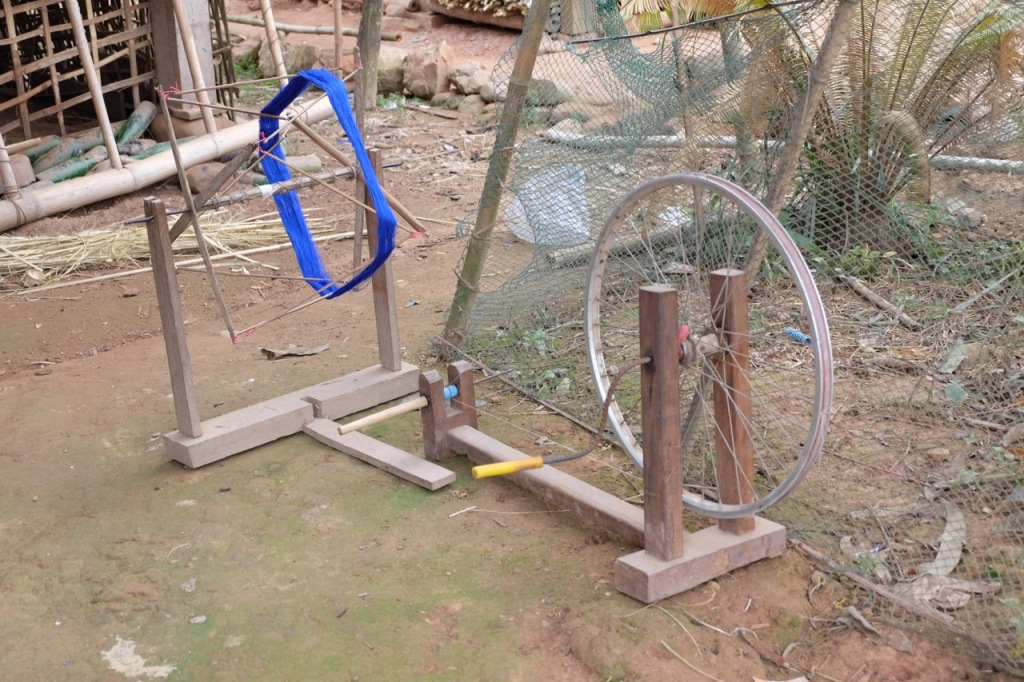
A traditional spinning wheel – photo taken near Luang Namtha

Weaver and her traditional loom, photo taken near Luang Namtha
This woman’s hands flew over her loom, reminding me of the way my mother made her knitting needles fly.
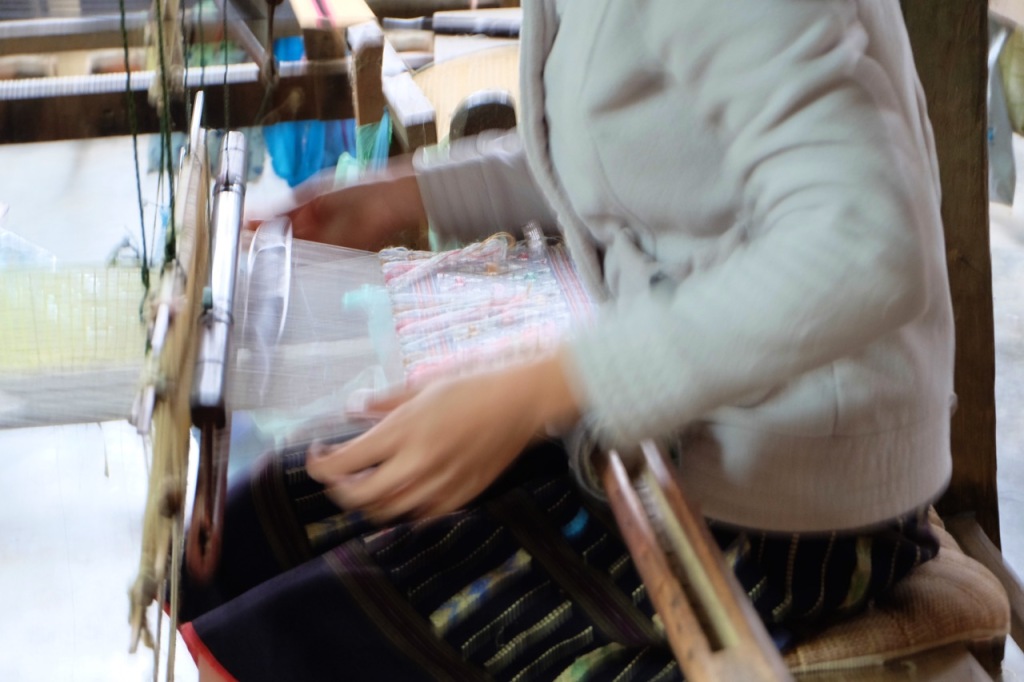
The blur of fast moving hands.
The TAEC Centre, with its particular focus on traditional arts and crafts, was a must visit for me.
Founded in 2006, TAEC collects, preserves, and interprets the traditional arts and lifestyles of the country’s many and diverse ethnic groups. (http://www.taeclaos.org/ourwork.html)
When I visited in January the exhibits included a display of traditional clothing from Akha, (H)mong, Kmhmu, and Tai Lue ethnic groups. The detail in each of the garments was quite simply stunning. They take many months to complete.
This set of women’s clothing is from the Luma people, a sub group of the Akha ethnic group, from Phongsali, in Northern Laos. It blends traditional patterns and methods with modern threads and materials.
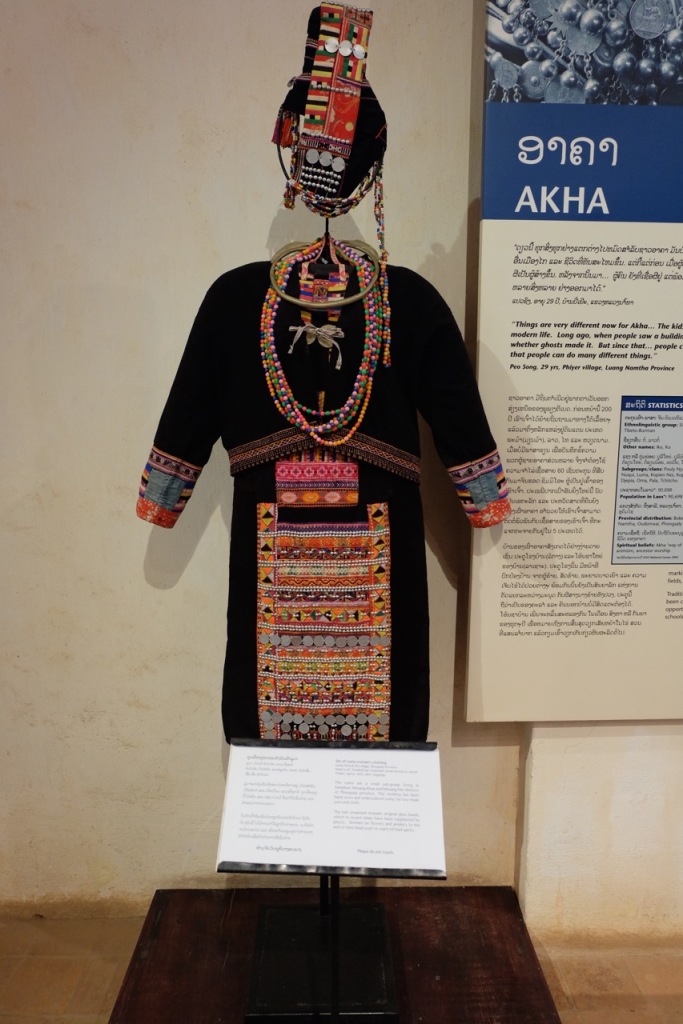
Set of women’s clothing – Luma sub-group
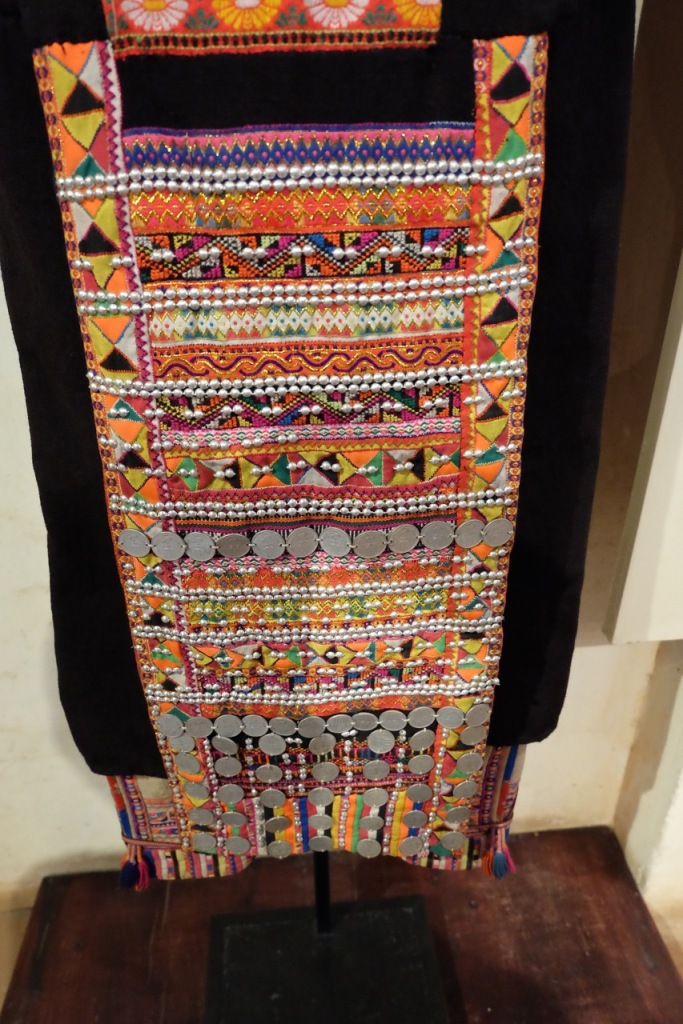
Detail on the front panel of a Luma woman’s skirt
The accordion pleats in this traditional Mong skirt are stitched into place and then the garment is stored while the pleats set. These skirts must be very heavy to wear!
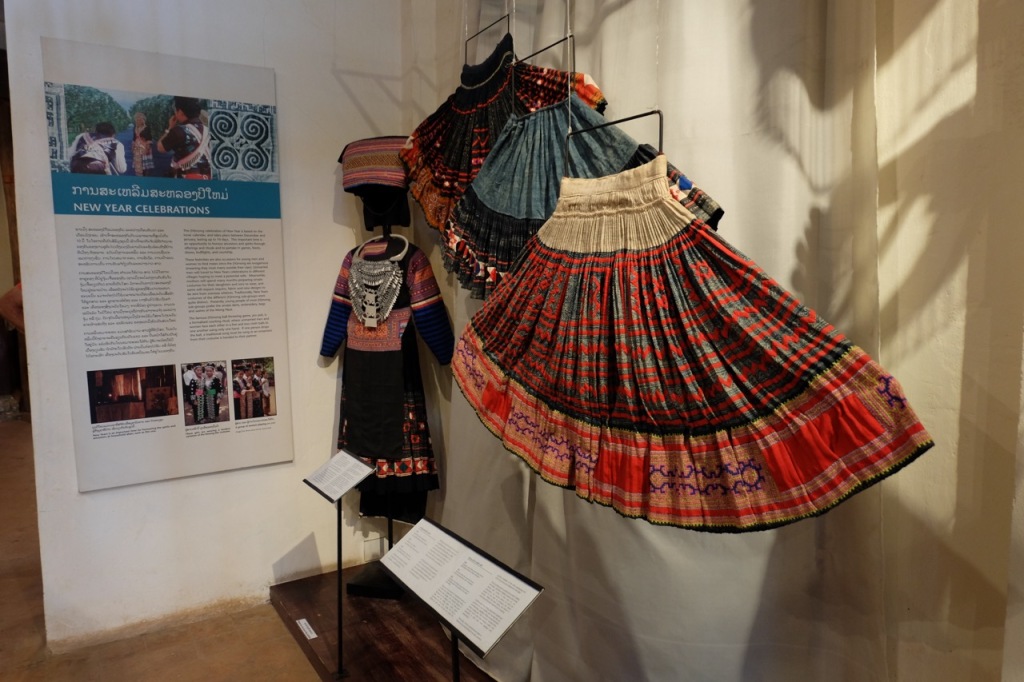
Traditional Mong skirt on display at the Taec Centre in Luang Prabang
While we were in Phongsali and Luang Namtha provinces, in Northern Laos, I frequently saw women in traditional dress. However, they didn’t like to have their photos taken – a matter I’ve discussed in an earlier post.
The YouTube clip below is an interview with a craftswoman conducted as part of the research of TAEC Centre. It’s fascinating viewing. The woman is in her late fifties and has more than thirty years experience. She designs and makes the patterns, all by freehand, for skirts similar to those in the above photo. The clip not only demonstrates how highly skilled she is, it also reveals, as is the case for many people in Laos, her precarious circumstances. She has worked all her life and now, without sons who will support her, she worries about getting enough food.
If you wish to know more about food insecurity in Laos this IRIN article provides an informative analysis of child and maternal malnutrition.
This post was developed in part as a response to The Daily Post’s weekly photo challenge: “Blur.”
Categories: Laos, Off-shore Adventures


I was so glad to see her laughing at least once in the video. It is hard work and a hard life for so little monetary reward. And what skill and patience she (and the others) have to create these patterns!
LikeLike
The YouTube clip is fascinating, isn’t it, VioletSky. And yes, it was nice to see her laugh. I think she was very proud of her work and rightly so.
LikeLike
Such intricate and beautiful patterns and colours, the video was a real insight to the little ladies life and the amount of time and work involved. You say some goods in the market are imported. Are they from China? and do they undercut the locals price?
LikeLike
Hi there pommepal! Yes the imported goods are mostly from China and, I think, mass produced. And not what most tourists want, of course. I know when I’m shopping I’m looking for something locally made as a memento from my time in that place.
LikeLike
Locally made takes a lot of searching for these days in NZ and Australia, but worth searching for and supporting the locals
LikeLike
You’re right there, Pauline!
LikeLiked by 1 person
What a sad life the little lady has! ‘Runaway husband pattern!’ I watched engrossed as she marked them out, Jill. Many thanks for sharing. 🙂
LikeLike
That YouTube clip is fascinating, isn’t it, Jo. I’m still full of admiration for her skill! And her sheer grit!!
LikeLiked by 1 person
Great post, Jill! Keep up your energy and your doing of these great reports! You talk and you really walk “A SMALL TOWN TAKE ON THE BIG, WIDE WORLD.” Bravo, my friend! 🙂
LikeLike
Thanks so much for all your encouragement, Fabio 🙂
LikeLiked by 1 person
Excellent post, and very sobering to realise how precarious these people’s livelihoods are….
LikeLike
Sobering is definitely the word. There’s no, or very little, social security.
LikeLiked by 1 person
Reblogged this on Covey View and commented:
Jill’s blog of art work of Northern Laos is beautifully written and illustrated.
LikeLike
Thanks so much for the reblog Meredith! And for all your encouragement.
LikeLiked by 1 person
Wonderful post with great photos. I really love the shot of the woman at her loom. Those blurred hands say everything!
LikeLike
She was hard at work, that’s for sure, Su.
LikeLiked by 1 person
Great post. In my travel to those parts, I realised that the income derived from the production of traditional handcrafts as well as, or in tandem with, tourism is promoted as a viable solution to the gap left by the demise of the Opium trade. Loved reading this post.
LikeLike
Good point, Johnscene. I didn’t see any sign of the opium trade at all on this trip.
LikeLiked by 1 person
Loved this post… About a decade ago, my sister and I spent a couple weeks in Laos over the Christmas holiday. It was perfect, and we both fell in love with the area, and with the handicraft they were producing. You really cover this so well (and in so much detail than we did!), brilliant post. Wish you a great weekend.
LikeLike
Ah, Dalo, for me it seems as if this part of the world is in my blood now. I’m fascinated by it.
LikeLike
It is a part of the world that still holds onto the important small things of the past. I too am fascinated by this part of the world and try to get back there as much as I can. 🙂
LikeLiked by 1 person
I understand why!
LikeLike
love the weaver’s hands! lovely shots!
LikeLike
Thanks!
LikeLiked by 1 person